In today's world, financial stability feels like a luxury reserved for the privileged. As inflation wreaks havoc across nations like Argentina and Turkey, many are turning to cryptocurrencies for refuge. Among these digital assets, Tether's USDT stands out as a preferred choice. But is it the best stablecoin out there? Let's dive into this topic.
Understanding Stablecoins and USDT's Position
Stablecoins are cryptocurrencies designed to maintain a stable value by pegging them to real-world assets, typically fiat currencies like the US dollar. The most prominent of these is Tether's USDT, which boasts a staggering market cap of around $120 billion, making it the third-largest cryptocurrency overall, trailing only Bitcoin (BTC) and Ethereum (ETH).
USDT's dominance in the crypto space is hard to overlook. It's widely used across various platforms and has become an integral part of decentralized finance (DeFi) ecosystems. However, its role extends beyond that; in countries facing economic turmoil, it serves as a crucial lifeline.
The Appeal of USDT in Hyperinflationary Contexts
Take Argentina or Turkey as examples—countries where inflation rates are spiraling out of control. In such scenarios, USDT offers a stable alternative to national currencies that are losing value by the minute. According to Paolo Ardoino, Tether’s CEO, before the advent of USDT, people had no choice but to turn to black markets for dollars. Now they have a more accessible option that helps safeguard their savings from devaluation.
One reason for USDT's popularity in these regions is its liquidity and ease of access. It facilitates smooth cross-border transactions while acting as a reliable store of value amidst chaos. That said, it's not without competition; other stablecoins like USD Coin (USDC) are also making headway.
Weighing the Pros and Cons: USDT vs. Other Stablecoins
Despite its widespread use, USDT has faced scrutiny over transparency issues regarding its reserves. Tether claims that every single USDT is backed 1:1 by actual fiat currency; however, questions linger about what exactly constitutes those reserves.
In contrast, USD Coin (USDC), issued by Circle, boasts full backing with cash and short-term U.S. government bonds—assets considered safe even during crises. Regular audits add another layer of assurance that makes many users prefer it over less transparent options.
Other alternatives exist too; TrueUSD (TUSD) and Pax Dollar (USDP) offer solid backing structures along with transparency through independent attestations.
Potential Risks Associated with Relying on USDT
While relying on any stablecoin in countries with fragile banking systems poses risks—especially one as contentious as USDT—several concerns stand out:
- Run Risk: If everyone tries to redeem at once.
- Credit Intermediation: Shifting deposits from banks could destabilize them.
- Systemic Risk: Broad adoption without safeguards can lead to crises.
A recent report from the Bank for International Settlements outlines these risks alongside others specific to emerging markets with weak banking infrastructures.
Summary: Is There A Better Alternative?
So is USDT really the best option? While it's undeniably liquid and widely accepted, its potential pitfalls might make other options more appealing—especially those prioritizing transparency and regulatory compliance like USDC or TUSD.
In hyperinflationary contexts where diverse financial tools are essential for survival, being informed about your choices could make all the difference.
